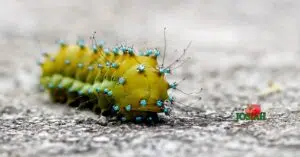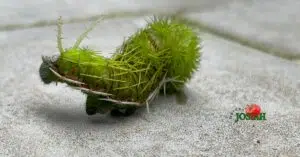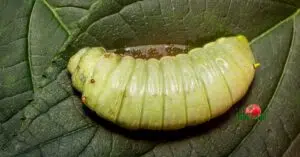Did you know green caterpillars are key to our ecosystems1? They are a main food source for many animals, from birds to insects1. Their change into colorful butterflies and moths also helps plants reproduce, adding to our world’s beauty1.
Get ready to explore the amazing world of green caterpillars. We’ll look at their life cycle, where they live, and how they adapt. You’ll learn about 10 species that show their incredible variety2. From the huge hickory-horned devil to the stunning Cecropia moth caterpillar, their secrets will amaze you2.
Key Takeaways
- Green caterpillars play a vital role in maintaining ecological balance as food sources and pollinators.
- Some green caterpillar species have evolved toxic defenses to enhance their survival rates.
- Conservation efforts and educational programs are crucial for the survival of green caterpillars.
- The world of green caterpillars is home to a diverse array of fascinating species, each with its own unique adaptations and behaviors.
- Debunking myths and misconceptions about green caterpillars can promote a better understanding of their ecological significance.

Introduction to the Captivating World of Green Caterpillars
The world of green caterpillars is full of stories of survival and adaptability. They play a key role in keeping our ecosystems balanced3. From the tiny Angle Shades Moth Caterpillar to the large Cecropia Moth Caterpillar, they are vital to nature’s web of life.
Significance of Green Caterpillars in the Ecosystem
Green caterpillars are more than just observers in nature. They are crucial, helping to keep their habitats healthy and diverse. By eating plants, they become food for many animals, from birds to small mammals3. This helps the ecosystem thrive, as energy from plants supports life in the food chain.
Overview of the Article’s Content
This article dives into the world of green caterpillars, covering their unique traits and roles in ecosystems. We’ll look at how they avoid predators and their complex relationships with others. By the end, you’ll understand how important green caterpillars are and why we must protect their homes.
The Life Cycle of Green Caterpillars
The life cycle of green caterpillars is fascinating, with four stages: egg, larva, pupa, and adult. Each stage is crucial for their survival and the balance of nature.
Female butterflies lay eggs on host plants, giving the caterpillars a rich food source4. The caterpillars then grow fast, eating a lot of leaves5. When they’re big enough, they transform into a butterfly or moth in the pupal stage.
- The egg stage: Female butterflies lay eggs on host plants, ensuring a ready food supply for the emerging caterpillars.
- The larval stage: Caterpillars hatch from the eggs and begin their rapid growth, feeding extensively on the leaves of their host plants5.
- The pupal stage: As the caterpillars reach a certain size, they enter the pupal stage, undergoing a remarkable transformation within the chrysalis4.
- The adult stage: The final stage of the life cycle is the emergence of the adult butterfly or moth, which then continues the cycle by finding a mate and laying more eggs.
| Caterpillar Species | Wingspan (inches) |
|---|---|
| American Lady | 1¾–25/86 |
| Black Swallowtail | 1¾–25/86 |
| Cecropia Moth | 4¾–66 |
| Luna Moth | wider than 4½6 |
| Monarch Butterfly | 3½–4½6 |
| Mourning Cloak Butterfly | around 36 |
| Eastern Tiger Swallowtail | 4½6 |
| White-marked Tussock Moth | medium-sized6 |
The life cycle of green caterpillars is a captivating testament to the wonders of nature. From the delicate eggs to the remarkable metamorphosis, these creatures play a vital role in the intricate tapestry of our ecosystem4.

Natural Habitat and Distribution of Green Caterpillars
Green caterpillars are found in forests, gardens, and farms. They live in many places, each with its own special needs. This lets them grow and survive well7.
Forests and Woodlands
Forests are home to many green caterpillars. These areas have lots of plants for them to eat and grow on7. The trees and bushes also give them places to hide and stay safe from predators7.
Gardens and Agricultural Areas
Green caterpillars also live in gardens and farms. They eat different plants here, like flowers and vegetables7. Sometimes, they can harm these plants, so farmers watch them closely8.
Where green caterpillars live often depends on the plants they like. They can be found in forests or gardens, showing how adaptable they are7.
| Habitat | Dominant Plant Species | Common Green Caterpillar Species |
|---|---|---|
| Forests and Woodlands | Oak, Maple, Ash, Birch | Polyphemus Moth, Io Moth, Swallowtail Butterfly |
| Gardens and Agricultural Areas | Tomato, Cabbage, Broccoli, Roses | Cabbage Looper, Tobacco Hornworm, Tomato Hornworm |
Ecological Importance of Green Caterpillars
Green caterpillars are key to keeping our ecosystems in balance. They are a main food source for many animals, like birds, mammals, and other insects9. With over 3,000 moth species in woods and fields, they are at the base of many food chains9.
In Ohio alone, the weight of all caterpillars is more than White-tailed Deer9. This shows how big their impact is in the environment.
Green caterpillars do more than just feed animals. They also help plants by pollinating them when they turn into butterflies and moths9. This is vital for keeping our ecosystems healthy and diverse. The “Growing Caterpillars” program at the Columbus Natural History Society teaches us about their importance in conservation9.
Butterflies get more attention, but moths are actually more common, with 20 times as many species9. Moth caterpillars help keep songbirds from disappearing and keep plant diversity alive9.
In short, green caterpillars are vital to our world. They feed many animals and help plants grow. Knowing how important they are helps us protect our ecosystems.
Unique Adaptations of Green Caterpillars
Green caterpillars are experts at hiding, using their bright colors to blend into leaves. Their camouflage helps them avoid predators, a key survival skill when they’re young10.
But they have more tricks up their sleeves. Many green caterpillars are also toxic to keep predators away. This toxicity comes from the plants they eat, making them less appealing to predators11.
Camouflage
The green color of these caterpillars helps them hide in leaves and foliage. They become almost invisible, protecting them from hungry predators10.
Toxicity
Some green caterpillars have evolved to be toxic. They get this toxicity from the plants they eat. This way, they can defend themselves against predators11.
| Caterpillar Species | Toxic Adaptations |
|---|---|
| Saddleback Caterpillar (Acharia stimulea) | Can inject small amounts of venom upon touch, causing a sting similar to a wasp sting11. |
| Puss Caterpillar (Megalopyge opercularis) | Possesses stinging spines beneath dense hairs that can cause long-lasting pain and even send people to the ER11. |
These amazing adaptations show how green caterpillars survive in the wild. They use camouflage and toxicity to stay safe1011.
“Caterpillars employ various tactics to avoid predators, such as bright colors, mimicry, and camouflage.”10
The Fascinating World of Green Caterpillars: 10 Species You Need to Know About
The world of green caterpillars is truly captivating. It has a wide range of species, each with unique traits and ways to adapt. From the Eastern Tiger Swallowtail Caterpillar to the Great Moth Caterpillar, these creatures are key to many ecosystems12.
The Cabbage White Caterpillar is one of the most common. It has a soft green body and yellow stripes. These caterpillars can grow up to 1-1.5 inches long12. The Tomato Hornworm Caterpillar is also well-known. It can grow up to 4 inches long12.
The Luna Moth Caterpillar is a beauty, reaching 2-3 inches in length. It eats leaves from trees like birch and walnut12. The Io Moth Caterpillar changes color as it grows. It starts reddish-brown and turns light green with stripes13.
| Caterpillar Species | Distinguishing Features | Habitat and Distribution |
|---|---|---|
| Eastern Tiger Swallowtail Caterpillar | Striking green color and eye spots | Forests and woodlands |
| Black Swallowtail Caterpillar | Green with yellow and black markings | Gardens and agricultural areas |
| Great Moth Caterpillar | Large green caterpillar with distinctive markings | Forests and woodlands |
| Winter Moth Caterpillar | Two pairs of green legs and white stripes | Invasive in Europe and the Near East, feeding on oak, maple, willow, and beech trees |
| Imperial Moth Caterpillar | Can measure up to 5.5 inches in size, not poisonous | Found from Argentina to Canada, feeding on various plants |
These are just a few examples of the fascinating green caterpillar species. Each one shows a unique side of the natural world. From the Cabbage Looper Caterpillar’s camouflage to the Hickory Horned Devil Moth Caterpillar’s intimidating look, they all offer a glimpse into the world of green caterpillars13.
Caterpillars are vital to the ecosystem. They are food for many predators and are key in the life cycle of butterflies and moths14. By learning about these creatures, we can appreciate nature’s balance and the need to protect their habitats12.
“Caterpillars can consume up to 27,000 times their body weight during their life cycle stage.”14
Conclusion
Green caterpillars are amazing creatures that are key to our ecosystems. They go through a fascinating life cycle, from tiny to up to 10 cm long15. They also have cool defenses like spines and fake eyespots to keep predators away15.
These larvae are part of the lepidoptera family16 and are not just interesting to watch. They are also vital for the ecosystem. They feed other animals and help move nutrients around16.
To keep these creatures alive, we need to protect their homes and avoid harmful chemicals. We should also help make gardens more diverse15.
This article has shown us the amazing world of green caterpillars. We’ve learned about their homes, their role in nature, and how special they are. By caring about green caterpillar conservation, we can help these important animals survive. Let’s all support these incredible larvae so they can keep thriving for years to come.
FAQ
What is the life cycle of green caterpillars?
Green caterpillars go through four stages: egg, larva, pupa, and adult. The larva stage is when they eat a lot and grow fast. Then, they change into a pupa before becoming a butterfly or moth.
Where can green caterpillars be found?
You can find green caterpillars in forests, gardens, and fields. They love wooded areas and eat tree leaves. They also live in gardens and farms, eating plants.
What is the ecological importance of green caterpillars?
Green caterpillars are key to keeping nature in balance. They are food for birds, mammals, and other insects. As butterflies and moths, they help plants by pollinating flowers.
What are some unique adaptations of green caterpillars?
Green caterpillars have special tricks to stay safe. Their green color helps them blend in with leaves. Some even get toxic from the plants they eat, making them unappealing to predators.
What are some common species of green caterpillars?
Some well-known green caterpillars are the Eastern Tiger Swallowtail and the Black Swallowtail. The Great Moth Caterpillar is also famous for its large size and green color.
Source Links
- Exploring The Fascinating World Of Green Caterpillars
- 10 Remarkable Types of Caterpillars and What They Become
- Discover the Fascinating Big Green Caterpillar
- Life cycle / Cycle of life
- Moths and Caterpillars
- Transformations: Which Caterpillar Becomes… | Summer 2010 | Ar
- Harris’s Three-spot caterpillar, a weird animal indeed
- Caterpillars Archives – Insect Diagnostic Lab
- Caterpillars are fascinating – really!
- Weekly Puzzler Answer #225 – Nature for my Soul
- caterpillars – Roads End Naturalist
- An illustrated guide to 32 green caterpillar species in your garden
- Green Caterpillars – Animal Corner
- Fascinating Facts, Behaviors and Traits of Caterpillars You Never Knew
- Uncovering The Fascinating World Of Caterpillars – Glenlivet Wildlife
- Green Caterpillars: A Guide to Identifying Common Species – Garden Josiah | We Grow Big







